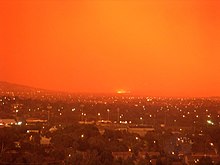2003 Canberra bushfires
| 2003 Canberra bushfires | |
|---|---|
 |
|
| Location | Canberra, Australian Capital Territory |
| Statistics | |
| Cost | $350 million |
| Date(s) | 8–21 January 2003 |
| Cause | Lightning strikes in Brindabella and Namadgi National Parks |
| Land use | Urban/rural fringe areas, farmland and forest reserves |
| Buildings destroyed |
488 |
| Injuries | 435 |
| Fatalities | 4 |
The 2003 Canberra bushfires involved several deaths, over 490 injured, and caused severe damage to the suburbs and outer areas of Canberra, the capital city of Australia, during 18–22 January 2003. Almost 70% of the Australian Capital Territory's (ACT) pastures, forests (pine plantations), and nature parks were severely damaged, and most of the renowned Mount Stromlo Observatory was destroyed. After burning for a week around the edges of the ACT, the fires entered the suburbs of Canberra on 18 January 2003. Over the next ten hours, four people died and more than 500 homes were destroyed or severely damaged, requiring a significant relief and reconstruction effort.
On 8 January 2003, lightning strikes started four fires in NSW, over the border but in close proximity to Canberra. Despite their proximity and very small initial sizes, low intensity, and low rate of spread, these fires were not extinguished or contained by NSW emergency services personnel. Subsequent inquiries into the bushfires, including the Roche report, the McLeod inquiry, and the Coroners Report, identified poor management of the initial response as a key contributor to the disaster that unfolded on 18 January 2003.
On 13 January, a helicopter that had been waterbombing the fires in the forests west of Canberra crashed into Bendora Dam with one person, the pilot, injured. ACT Chief Minister Jon Stanhope and Chief Fire Officer Peter Lucas-Smith were reviewing the fires nearby in the Snowy Hydro SouthCare helicopter. The pilot of the Southcare chopper cautiously positioned his aircraft to allow Stanhope, Lucas-Smith and a paramedic on board to dive into the dam and rescue the injured pilot. All three who rescued the injured pilot and the helicopter pilot later received awards for their bravery.
On 17 January, the Emergency Services Bureau (ESB) released its final media release prior to 18 January at 8:50 pm. This media release differed to any previous one in format and content. It also provided several clues that were overlooked in the assessment of the risk Canberra faced. For example, one point of the release stated that bushfire logistical support staging areas were being relocated from Bulls Head and Orroral Valley (far outside urban Canberra) to the North Curtin District Playing Fields (far inside urban Canberra), signalling both a major retreat by fire fighters and pointing to imminent danger to the city itself.
...
Wikipedia
